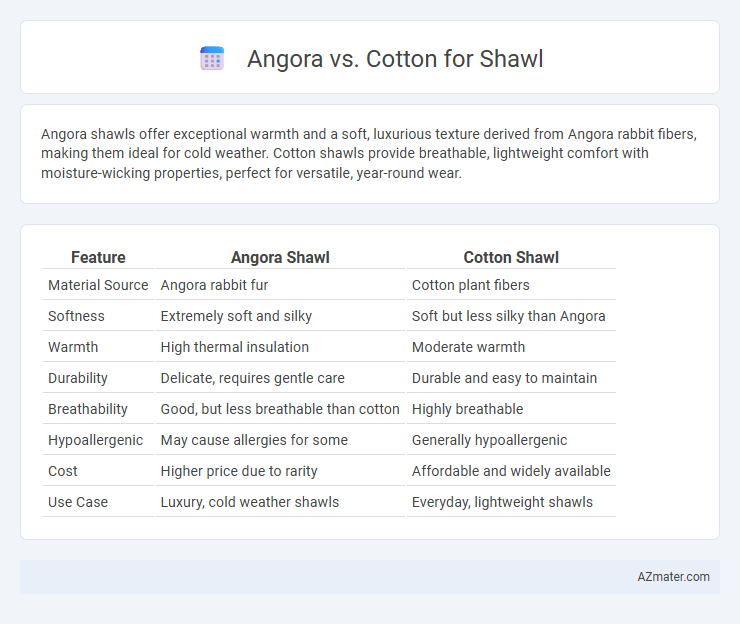Angora shawls offer exceptional warmth and a soft, luxurious texture derived from Angora rabbit fibers, making them ideal for cold weather. Cotton shawls provide breathable, lightweight comfort with moisture-wicking properties, perfect for versatile, year-round wear.
Table of Comparison
| Feature | Angora Shawl | Cotton Shawl |
|---|---|---|
| Material Source | Angora rabbit fur | Cotton plant fibers |
| Softness | Extremely soft and silky | Soft but less silky than Angora |
| Warmth | High thermal insulation | Moderate warmth |
| Durability | Delicate, requires gentle care | Durable and easy to maintain |
| Breathability | Good, but less breathable than cotton | Highly breathable |
| Hypoallergenic | May cause allergies for some | Generally hypoallergenic |
| Cost | Higher price due to rarity | Affordable and widely available |
| Use Case | Luxury, cold weather shawls | Everyday, lightweight shawls |
Introduction to Angora and Cotton Shawls
Angora shawls, made from the soft, luxurious fur of Angora rabbits, offer exceptional warmth and lightweight comfort, making them a premium choice for chilly weather. Cotton shawls, crafted from natural cotton fibers, provide breathability and moisture-wicking properties, ideal for moderate climates and everyday wear. Both fabrics cater to different needs, with Angora excelling in insulation and softness, while cotton stands out for durability and versatility.
Fiber Origins: Angora vs Cotton
Angora fiber originates from the Angora rabbit, prized for its exceptional softness, warmth, and lightweight characteristics, making it ideal for luxurious shawls. Cotton, derived from the natural fibers surrounding the seeds of cotton plants, is breathable, durable, and moisture-absorbent, offering comfort and versatility in shawl production. The animal-based Angora fibers provide superior insulation compared to the plant-based cotton fibers, influencing the texture and thermal properties of shawls.
Texture and Softness Comparison
Angora fibers are known for their exceptional softness and silky texture, providing a lightweight, luxurious feel that is warmer than cotton. Cotton shawls offer a smooth, breathable texture that is less insulating but highly durable and easy to care for. When comparing texture and softness, Angora delivers superior plushness and warmth, while cotton provides a crisp, cool comfort ideal for everyday wear.
Warmth and Insulation Properties
Angora, derived from Angora rabbits, offers superior warmth and insulation due to its hollow fiber structure that traps air efficiently, making it ideal for shawls in cold climates. Cotton, a plant-based fiber, provides moderate warmth but excels in breathability and moisture-wicking, which can reduce insulation effectiveness in colder conditions. Shawls crafted from Angora retain heat longer and offer a softer, more luxurious feel compared to cotton, which is better suited for mild temperatures and layering.
Breathability and Comfort
Angora fibers provide exceptional warmth and softness but lack the breathability of cotton, making cotton a better choice for shawls in warmer climates due to its superior moisture-wicking properties and air permeability. Cotton shawls offer lightweight comfort and enhanced airflow, which helps prevent overheating and irritation during extended wear. The natural absorbency and breathability of cotton make it ideal for maintaining comfort in varying temperatures, while angora's insulating qualities excel in cooler conditions.
Durability and Longevity
Angora shawls exhibit superior softness but require delicate handling due to their fine fibers, which may reduce durability compared to cotton. Cotton shawls offer greater resilience, with fibers that withstand frequent wear and washing without significant deterioration, enhancing longevity. Selecting cotton for shawls ensures a robust textile that maintains structural integrity over extended use, while angora demands careful maintenance to preserve its delicate quality.
Maintenance and Care Requirements
Angora shawls require delicate maintenance, including gentle hand washing in cold water with mild detergent and careful drying flat to prevent damage to the fine fibers. Cotton shawls are more durable and easier to care for, tolerating machine washing and regular drying without losing shape or softness. Proper storage for both materials involves keeping them away from moisture and direct sunlight to maintain fiber integrity and extend the lifespan of the shawl.
Allergen Concerns and Skin Sensitivity
Angora wool, derived from the Angora rabbit, often causes allergic reactions due to its fine fibers that can irritate sensitive skin and trigger itching or redness. In contrast, cotton shawls are hypoallergenic and breathable, making them suitable for individuals with skin sensitivities or allergies. Cotton's natural softness and moisture-wicking properties reduce irritation risks compared to the lanolin and keratin proteins found in Angora fibers.
Environmental Impact and Sustainability
Angora wool, sourced from Angora rabbits, raises environmental concerns due to ethical issues related to animal welfare and smaller-scale production impacts, though it is biodegradable and renewable. Cotton cultivation heavily impacts water resources, accounting for nearly 20% of global pesticide use and significant greenhouse gas emissions, but organic cotton varieties mitigate some environmental harm through reduced chemical inputs. Choosing between Angora and cotton for shawls involves weighing the sustainability of natural biodegradability and ethical sourcing against the intensive water and chemical footprint of conventional cotton farming.
Choosing the Right Shawl: Angora or Cotton?
Angora shawls offer unparalleled softness and exceptional warmth, making them ideal for cold climates and luxurious comfort. Cotton shawls provide breathability and lightweight durability, perfect for warmer weather and sensitive skin. Choosing between Angora and Cotton depends on the desired insulation level and seasonal use, with Angora excelling in warmth and Cotton in moisture-wicking properties.

Infographic: Angora vs Cotton for Shawl
 azmater.com
azmater.com